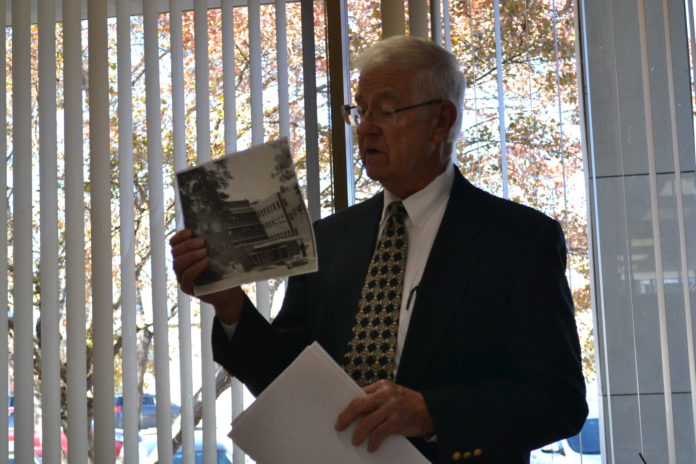
CULLMAN, Ala. – The history of medicine in Cullman County has been rich and interesting to date. Those at the Cullman County Public Library this Wednesday had the opportunity to learn about that rich history from retired physician Dr. Bill Peinhardt. The event was part of the Cullman County Public Library Fall Brown Bag Lecture Series.
Peinhardt began the timeline prior to 1800, when the Native Americans were devastated by the smallpox virus brought over by European settlers. Peinhardt noted that, depending on the source, up to 80-90% of the Native American population died from smallpox.
Cullman County’s medicinal history started with the story of Winifred Speegle from the 1840s. Daniel Speegle was one of the first settlers in the Logan/Brushy Pond area, and his son, David, married Winifred Cranford. It was noted that David and Winifred had 19 children, with four of their sons fighting in the Civil War. Peinhardt said Winifred provided medical care for the Logan area and as far as Falkville, and she was the only medical provider at that time. It’s said that the path she traveled became known as “Speegle Blaze,” because she would mark trees on the path with a hatchet to remember the way she was going.
Peinhardt said of the Civil War, “It was terrible, the brutality of it. If you got shot in the arm, your arm was amputated.”
Peinhardt said that in 1882, within Cullman the physicians were Dr. John Ulrich Steifelmeyer, who was the first health officer of the Cullman County Medical Society (which formed in 1886 with eight doctors), and Dr. Aldo Weiss- the cottage where he practiced is the oldest house in Cullman. Another noted physician in Cullman County was Dr. Charles Drennan, who ran a hospital in Arkadelphia in 1884.
Peinhardt said “hospitals” at that time were just another room in a physician’s house that had a “sick bed.”
By 1886, there were 23 practicing physicians in Cullman County. Peinhardt noted that becoming a physician back then wasn’t a difficult task.
“There wasn’t any uniformity to physicians,” he said. “You worked with a doctor for six months and they’d say, ‘You’re good to go.’”
In 1899, a “Dr. Martin” was the first to use aspirin in Logan. In 1900, the first surgery was recorded; it was a removal of a goiter by a “Dr. Hayes and Dr. Culpepper.”
In 1910, nationally, The Flexner Report was the first attempt to try and standardize medical care from Washington. Peinhardt noted the report said women could not be physicians.
Back in Cullman County, by 1916 there was a hospital in Joppa that had five patient rooms. Peinhardt didn’t have the name of the physician who worked in the Joppa Hospital.
By 1918, World War I was underway with a horrible flu pandemic and tuberculosis making a breakthrough. Peinhardt mentioned there was even a city ordinance passed that outlawed spitting on sidewalks to help cease the spread of TB.
The Tribune checked Cullman’s list of ordinances with Administrative Assistant to Cullman Mayor Woody Jacobs, Leanne West, who found a section in the Cullman Code of 1926, a codification of all existing city ordinances as of 1926, that stated, “It shall be unlawful for any person to spit on the floor of any public building, or on the stairway thereof, or throw cigar stumps, tobacco, or other filth thereon, and any person violating the provisions of this section shall be guilty of a misdemeanor and on conviction shall be fined not less than two nor more than ten dollars.”
Continuing with Peinhardt’s lecture, the next big medical happening in Cullman County occurred in 1939, when the Cullman Hospital (now the Folsom Center) was completed. The cost to stay a day was $4 with five nurses on staff and 31 beds for patients. Then in 1940, the life expectancy lengthened to the age of 60. In 1941, during World War II, penicillin was developed and was a major breakthrough in the medical world.
After some time, in 1969, the Cullman Hospital became accredited, with 107 patient beds, five set aside for an intensive care unit (ICU). In 1972, with eight hospitals (including the Cullman Hospital), the Baptist Hospital Association (BHA), said Peinhardt, would “get together and have quality control meetings. It was an excellent thing.”
Peinhardt praised the BHA, saying, “It was one of the best management systems I was under.”
In 1972, Woodland Medical Center was built; it closed in July 2009. And finally, in 1995, Cullman Regional Medical Center (CRMC) opened.
Peinhardt was a physician in the Cullman area for 40 years. He retired in 2016.
Copyright 2019 Humble Roots, LLC. All Rights Reserved.


























